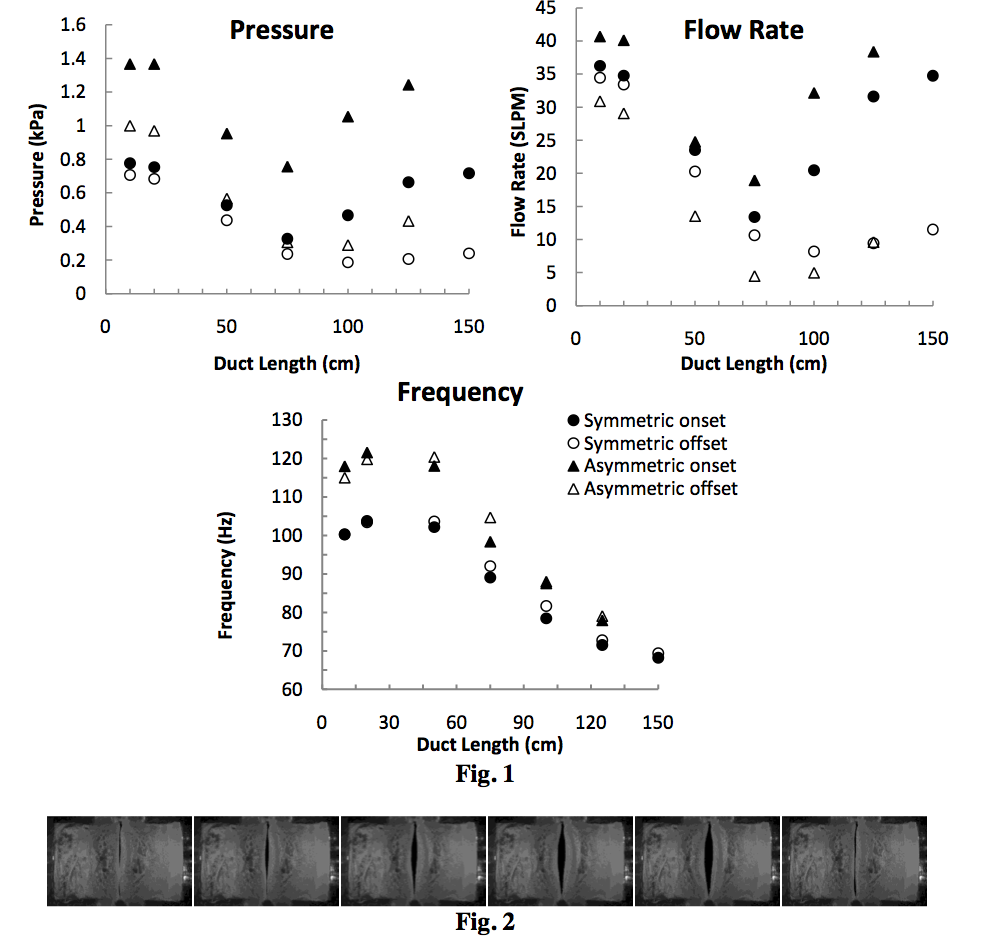Kimberly Stevens and Dr. Scott Thomson, Department of Mechanical Engineering
Background and Motivation
The flow-induced vibration of the human vocal folds produces the sound for voiced speech and singing. The vocal folds consist of two folds of tissue, one on each side of the larynx, that are nominally symmetric in terms of shape, composition, and stiffness. However, several voice disorders, including vocal fold scarring and inflammation, cause severe asymmetry in vocal fold tissue properties. The asymmetry can lead to irregular vocal fold vibration and subsequent decrease in voice quality. A more accurate understanding of the effect of vocal fold asymmetry can aid in the development of improved clinical care of the human voice. Research to quantify the effect of tissue asymmetry on vocal fold vibration was recently performed using synthetic vocal fold models1. However, this study was performed using simplified models that lack important qualities related to mimicking vocal fold motion. New models2 have recently been developed that yield much more life-like vibratory responses. In this project, vocal fold stiffness asymmetry was studied using the new models, allowing for investigation of physical phenomena not previously considered. In addition to asymmetry, the length of the flow supply tube leading to the model has a significant effect on vibration and was also tested in this study in order to better understand model response.
Procedure
To test the effect of material stiffness asymmetry on model vibration, four different models were made: two models with typical, “healthy” stiffness and two slightly stiffer models. The healthy models were fabricated using a three-part silicone mixture in the cover layer (see [2] for details) of one part A, one part B, and eight parts thinner, or 1:1:8. The stiffer models used a mixture ratio of 1:1:6.5 (less thinner for a stiffer model). This allowed for pairing of the healthy models with each other and for one healthy model to be paired with one stiffer model. Data from each model combination were acquired with duct lengths of 10, 20, 50, 75, 100, 125, and 150 cm; however, excessive vibration at the longer duct lengths damaged the models and complete data for all duct lengths were unavailable. The duct length of 20 cm is closest to the trachea length of an adult human male. During model vibration onset and offset pressure, frequency, and flow rate were recorded three times for each model combination. Upstream microphone data were also collected. High speed video was acquired of the superior surface of the models as they were vibrated at 110 % of their onset pressure, along with microphone data.
Results
Average onset pressures, frequencies, and flow rates are plotted as a function of duct length for the symmetric and asymmetric cases in Fig. 1. Figure 2 shows a sequence of high-speed images of the healthy model.
Discussion and Conclusions
More work remains before obtaining conclusive results concerning the effect of tissue stiffness asymmetry, but this study has provided information helpful in further understanding vocal fold vibration. The following are a few observations. First, the effect of duct length on model vibration was found to be very significant. Second, the fragile nature of the new model resulted in damage when being vibrated at longer duct lengths. Third, some initial conclusions regarding the effect of asymmetry on model vibration can be drawn. The data showed that the stiffer the cover layer, the higher the onset pressure, flow, and frequency. There also seems to be a greater gap between onset and offset pressure and flow for the shorter duct lengths with the stiffer covers. The asymmetric (1:1:8 with 1:1:6.5) case had a higher onset and offset pressure and flow than the symmetric case. In general the shape of the curves tended to be similar in all cases, showing that duct length has a significant effect on the vibration pattern, independent of asymmetry. It had been hypothesized that the left and right models would vibrate out of phase with each other in the asymmetric case. However, from the high speed video imaging, it was concluded that this was not the case at any of the duct lengths tested.
Scholarly Sources
- Pickup BA, Thomson SL. 2009. Influence of asymmetric stiffness on the structural and aerodynamic response of synthetic vocal fold models, J. Biomechanics 42:2219-25.
- Murray PR, Thomson SL. 2011. Synthetic, multi-layer, self-oscillating vocal fold model fabrication, J. Visualized Experiments 58:e3498.

